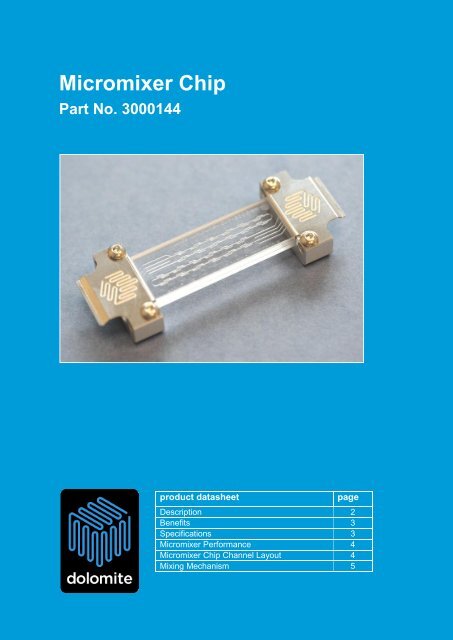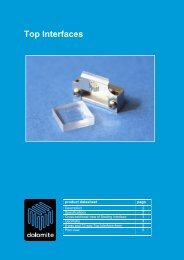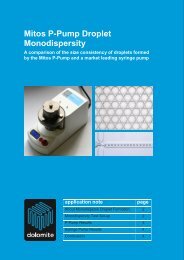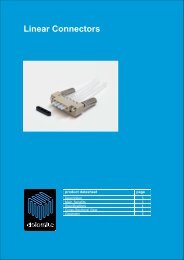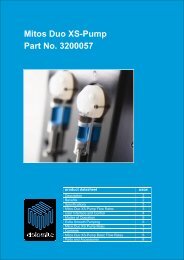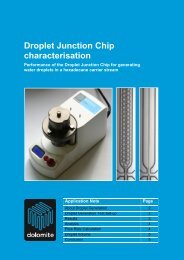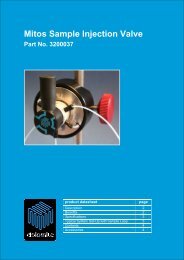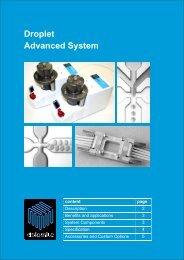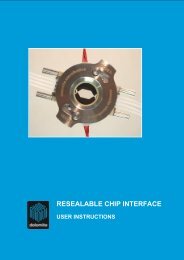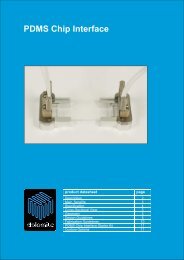datasheet - Dolomite Microfluidics
datasheet - Dolomite Microfluidics
datasheet - Dolomite Microfluidics
Create successful ePaper yourself
Turn your PDF publications into a flip-book with our unique Google optimized e-Paper software.
The <strong>Dolomite</strong> Centre Ltd<br />
Unit 1, Anglian Business Park, Orchard Road,<br />
Royston, Hertfordshire, SG8 5TW, UK<br />
T: +44 (0)1763 242491<br />
F: +44 (0)1763 246125<br />
E: sales@dolomite-microfluidics.com<br />
W: www.dolomite-microfluidics.com<br />
Micromixer Chip<br />
Part No. 3000144<br />
<strong>Dolomite</strong> <strong>Microfluidics</strong> – North America Office<br />
Blacktrace Inc, 29 Albion Place<br />
Charlestown, MA 02129, USA<br />
C: 617 803 6655<br />
T: 617 848 1121<br />
F: 617 500 0136<br />
E: salesus@dolomite-microfluidics.com<br />
product <strong>datasheet</strong><br />
page<br />
Description 2<br />
Benefits 3<br />
Specifications 3<br />
Micromixer Performance 4<br />
Micromixer Chip Channel Layout 4<br />
Mixing Mechanism 5<br />
The <strong>Dolomite</strong> Centre Limited Page 1 of 6
The <strong>Dolomite</strong> Centre Ltd<br />
Description<br />
The Micromixer chip is a glass microfluidic device designed for rapid mixing of two or<br />
three fluid streams. Fast mixing times are required for the study of reaction kinetics,<br />
sample dilution, improving reaction selectivity, rapid crystallisation and nanoparticle<br />
synthesis.<br />
There are two independent micromixer channels on the chip and two headers allowing<br />
connection with the Linear connector 4-way (Part No. 3000024).<br />
Above:<br />
Micromixer Chip with two Linear<br />
Connectors 4-way (Part No. 3000024)<br />
Left: Micromixer Chip (Part No. 3000144)<br />
Benefits<br />
Extremely rapid mixing across a range of flow rates<br />
Low dead volume<br />
High visibility (excellent access for optics)<br />
Quick connect / disconnect<br />
Wide temperature and pressure range<br />
Excellent chemical compatibility<br />
Micromixer Chip_product <strong>datasheet</strong> Page 2 of 6
The <strong>Dolomite</strong> Centre Ltd<br />
Specifications<br />
Specification<br />
Value<br />
Number of inputs 3<br />
Number of outputs 1<br />
Internal channel cross section<br />
Internal volume of micromixer 8µl<br />
125µm x 350µm and 50µm x 125µm (depth x<br />
width)<br />
Internal volume of a mixing stage<br />
Back pressure with 100 l/min flow (water)<br />
Outside diameter of connection tubing<br />
Inside diameter of connection tubing<br />
Connection tubing material<br />
Surface roughness of channels (R a )<br />
Chip size<br />
Chip top layer thickness<br />
Chip base layer thickness<br />
0.35µl<br />
0.1bar<br />
1.6mm (1/16 inch)<br />
0.25mm provided as standard<br />
PTFE, FEP<br />
5nm<br />
50mm x 15mm<br />
2mm<br />
2mm<br />
Operating pressure 30 Bar *<br />
Operating temperature 150 C **<br />
Material<br />
Fabrication process<br />
* Based on tests at 21 C<br />
Glass<br />
HF etching and thermal bonding<br />
** See specification for connector<br />
Micromixer Chip_product <strong>datasheet</strong> Page 3 of 6
The <strong>Dolomite</strong> Centre Ltd<br />
Micromixer Performance<br />
To measure mixing performance a transparent phenolphthalein pH marker was mixed<br />
with an alkali solution to produce a bright pink colour. This is shown in the image below.<br />
Alkali solution<br />
Mixing stage<br />
Phenolphthalein<br />
Alkali solution<br />
The mixing time was measured across a range of total flow rates from 5μl/min to<br />
5000μl/min. This was done by counting the number of mixing stages required to achieve<br />
complete mixing, as shown in the table below. Mixing time was then calculated by dividing<br />
the volume of the required mixing stages by the volumetric flow rate. The volumetric flow<br />
rate ratio between the two input streams was 1:1 in all cases.<br />
Flow rate<br />
(μl/min)<br />
Number of<br />
stages required<br />
for complete<br />
mixing to occur<br />
Mixing time<br />
(milliseconds)<br />
5 10 20 40 80 160 320 640 1200 2000 3000 4000 5000<br />
1 1 2 4 6 7 7 4 4 3 3 2 2<br />
4200 2100 2100 2100 1575 919 459 131 70 32 21 11 8<br />
Micromixer Chip Channel Layout<br />
The channel geometry of the Micromixer chip is shown below:<br />
Miixing stage<br />
Input 1<br />
Input 2<br />
Input 3<br />
Output<br />
Micromixer Chip_product <strong>datasheet</strong> Page 4 of 6
The <strong>Dolomite</strong> Centre Ltd<br />
Mixing Mechanism<br />
The Micromixer is a static mixer (no moving parts), which at low flow rates creates<br />
lamination of the flow streams as shown in the diagram below:<br />
The lamination of the streams reduces diffusion distances and hence improves mixing<br />
time. At high flow rates swirling occurs in the flow streams, reducing mixing time further.<br />
Micromixer Chip_product <strong>datasheet</strong> Page 5 of 6
The <strong>Dolomite</strong> Centre Ltd<br />
Micromixer Chip_product <strong>datasheet</strong> Page 6 of 6


